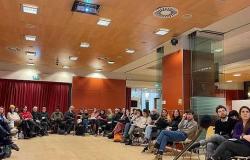One of the Herculaneum papyri with texts by Philodemus of Gadara, object of study by GreekSchools
In over a thousand words, corresponding to 30% of the text, read thanks to the cross between modern technologies and philological science, of the carbonized Herculaneum papyrus containing the History of the Academy of Philodemus of Gadara (110-after 40 BC), Plato’s burial place emerged.
New technologies are progressively making it possible to read the library found charred in the so-called Villa dei Papiri in Herculaneum. If the Vesuvis Challenge project is the one best known in the news, also because it is a sort of competition with prizes for those who decipher portions of text through artificial intelligence, it is not the only one working on the precious finds. Today in Naples, at the National Vittorio Emanuele III Library, the state of progress of the research of the “GreekSchools” project was presented.
Started in 2021 and lasting 5 years and eight months, GreekSchools is coordinated by Graziano Ranocchia of the University of Pisa in collaboration with the Institute of Cultural Heritage Sciences (ISPC) and the “Antonio Zampolli” Institute of Computational Linguistics (ILC) of the National Research Council, and the National Library of Naples where this papyrus, carbonized following the eruption of Vesuvius in 79 AD. C, is preserved together with many others in the Officina dei Papieri Ercolanesi. The project, in addition to investigating the state of conservation of these artefacts, has the aim of publishing an updated edition – thanks to the application of imaging techniques and philological methods – of the Review of Philosophers of Philodemus, the oldest history of Greek philosophy in our possession. It is precisely part of it History of the Academy, which contains much unique information about Plato and the development of the Academy under his successors. The text had already been partially read with traditional methods, because it was unrolled in the past with mechanical means. “Compared to previous editions, there is now an almost radically changed text, implying a series of new and concrete facts about various academic philosophers. Through the new edition and its contextualization, scholars have arrived at unexpected deductions of interdisciplinary scope for ancient philosophy, Greek biography and literature and the history of the book”, commented Graziano Ranocchia.
Among the news that has emerged there is also the information that Plato was buried in the garden reserved for him (a private area intended for the Platonic school) of the Academia in Athens, near the so-called Museion or sacellum sacred to the Muses. Until now it was only known that he was buried generically in the Academia.
“Some previous additions have been replaced, some previously fragmentary passages have been integrated or reread. The increase in the text corresponds roughly to the discovery of ten new medium-sized papyrus fragments. The new readings often draw on new and concrete facts about ‘Plato’s Academy, on Hellenistic literature, on Philodemus of Gadara and ancient history in general”, adds Kilian Fleischer, the editor of this precious papyrus within the GreekSchools project. In addition to the burial, we learn that Plato was sold as a slave on the island of Aegina perhaps already in 404 BC, when the Spartans conquered the island or, alternatively in 399 BC, immediately after the death of Socrates. Until now it had been believed that Plato had been sold into slavery in 387 BC during his stay in Sicily at the court of Dionysius I of Syracuse. In another passage, in a dialogue between characters, Plato expresses himself contemptuously about the musical and rhythmic abilities of a barbarian musician originally from Thrace.
There History of the Academy, preserved in two different reworkings, a first and provisional version (PHerc. 1691/1021) and a subsequent and definitive one (PHerc. 164), contains much information otherwise lost on the development of the Academy and on its most important figures, from Plato to Antiochus and Aristo of Ashkelon. In particular, the first part of PHerc. 1021 (cols. 1-21) represents a mosaic of passages copied or paraphrased directly or indirectly from lost works of philosophers, historians and biographers of early Hellenism such as Philip of Opus, Neanthes of Cyzicus, Philochoros, Dicaarchus, Diocles of Magnesia, Demochares, Hermippus, Phanias, Timaeus, Diodorus, Philiscus of Aegina, Lacydes, Antigonus of Charistos and Apollodorus.
“The GreekSchools project also aims to develop methods of investigation of manuscripts by applying the most advanced diagnostic imaging techniques available today (infrared and ultraviolet optical imaging, molecular and elemental imaging, thermal imaging, tomography, microscopy digital optics, etc.)”, specifies Costanza Miliani of the CNR-ISPC. Staff of this Institute, of the CNR-SCITEC and of other European research centres, using mobile instruments from the Molab platform belonging to the European research infrastructure on Heritage Science E-RIHS, apply non-invasive techniques to opisthographic papyri (i.e. writings on both sides) and layered in order to read text inaccessible on the reverse or hidden within multiple layers.
The innovations have in fact emerged from the reading, carried out for the first time, of sequences of letters hidden within multiple layers, which remained attached to each other after the unrolling done in past centuries with the mechanical technique that had caused the dislocation of entire text fragments. “This is a huge leap in quality, even if the study is only in its initial stages: we will only see the real impact in terms of knowledge in the coming years”, commented Graziano Ranocchia. “The multiple layers represent a dramatic problem for the reading of almost all the scrolls that have been unrolled, approximately 1,560 out of the 1,840 total that survived the eruption of Vesuvius in 79 AD”, explains Ranocchia. “These serious stratifications distort a large part of the texts, making it impossible to edit them. Finally being able to identify these layers and virtually relocate them to their original position to restore the continuity of the text means gathering an enormous amount of information compared to the past.”
Tags: Herculaneum papyri reveal Platos burial site





